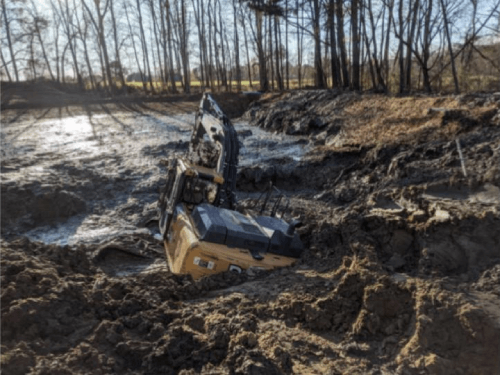
Matt Doll, Minnesota Environmental Partnership
On Thursday, August 4, the independent citizen science group Waadookawaad Amikwag – also known as Those Who Help Beaver – released evidence that Enbridge’s construction of its Line 3 oil pipeline did even more damage to Minnesota waters than previously known. In a new video, the group showed that the LaSalle aquifer is still leaking at the site where a breach caused by Line 3 construction was discovered a year ago.
The LaSalle aquifer, along with the lake and creek of the same name, sits near the headwaters of the Mississippi River. From below the surface, the aquifer feeds the wetlands with fresh water. These wetlands are a highly interconnected ecosystem that plays a crucial role in keeping the upper Mississippi clean, but that interconnectedness also makes the ecosystem vulnerable to system shocks.
Enbridge, unsurprisingly, inflicted such a shock to the system. Waadookawaad Amikwag’s video illustrates how Enbridge’s used steel sheet piling to stabilize the trench for its pipeline. Those steel sheets pierced the clay between the surface and the aquifer below, causing water to gush upward.
To “fix” this breach, Enbridge dug pipes into the clay, then pumped over 51,000 gallons of grout down to cap the aquifer. The concrete-like grout wall was meant to stop the water from escaping, but didn’t remotely mimic the natural processes that allow the aquifer to periodically feed the wetland. Nor, as it turned out, did it actually do what it was meant to.
Waadookawaad Amikwag worked with the White Earth Reservation, R.I.S.E. Coalition, and MEP members Honor the Earth, Sierra Club, and MN350 to conduct thermal imaging of the site last November – after Enbridge’s purported repair of the breach. The results led scientists to suspect that there were still plenty of leaks. Unseasonable temperatures in the creek around the site indicated that the aquifer’s warmer water was still bubbling up to the surface.
That’s bad news for the entire ecosystem. A pressure decrease in an aquifer can jeopardize its natural interaction with the surrounding wetlands, damaging or even drying them up. And that in turn is bad news for the Mississippi and the people who depend on its watershed, deprived of yet another natural process that keeps it clean. Even absent these breaches, that much concrete poured into the clay over an aquifer may have more uncertain consequences for the LaSalle Valley’s health.
No need – and no real accountability
MEP has long taken the position that this pipeline is not needed. But at the bare minimum, Enbridge should have listened to engineers and geologists about the danger of trenching through the LaSalle Valley. Experts – both independent and state-affiliated – raised concerns for years that sheet piling could harm Minnesota aquifers, especially in this location.
LaSalle isn’t the only place Enbridge breached an aquifer, nor where the pipeline is causeingongoing harm. At least two other breaches have occurred, and pipeline monitors are continuing to investigate along the route. The excavation process also produced frac-outs – spills of hydraulic fracturing fluid into the ecosystem. MEP has hosted webinars – one last September and one in January – where scientists and Indigenous leaders covered these issues in detail.
With this new information coming to light, Waadookawaad Amikwag, the R.I.S.E. coalition and allies are renewing the call for accountability from Enbridge. Yesterday, on the shores of LaSalle lake, they commemorated the one-year anniversary of the breach and called for a state and federal strategy to monitor and mitigate the pipeline’s impacts.
So far, state agencies have not enacted any meaningful consequences for the company’s actions, and the so-called fix of the aquifer has evidently done additional harm. It’s shocking, but perhaps unsurprising, that Enbridge has escaped the scrutiny that would significantly impact its business model.
This is the company that built a pipeline carrying the emissions equivalent of 50 coal-fired power plants every year, even when the state Commerce Department said the pipeline wasn’t needed. This is the company that has defied the state of Michigan’s order to shut down its Line 5 pipeline. This is the company that brought Minnesota the largest inland oil spill in U.S. history.
“Part of the tragedy here is that none of this is a surprise,” said Steve Morse, MEP’s Executive Director. “Indigenous leaders, environmental organizations and independent experts warned well before this project was permitted that Line 3’s construction would harm Minnesota’s water resources and ecosystems, and that its operation threatens our long-term health with spill risks and worsened climate change. Yet, the project moved through the established process without meaningful scrutiny by our Government agencies. We stand in solidarity with Waadookawaad Amikwag and other Indigenous and scientific leaders in calling for full accountability from Enbridge.”
For previous columns, visit mepartnership.org/category/blog/. If you would like to reblog or republish this column, you may do so for free – simply contact the author at matthew@mepartnership.org.